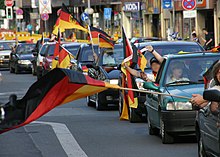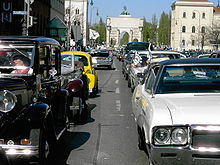Parade
The term Korso (from Italian corso = run, running track, main street, this in turn from Latin cursus = run, ride) comes from horse racing, but today mostly describes a slow journey of several vehicles in a city or of boats on the water.
history
Before the 18th century, Korso referred to a race of riderless horses, such as those that took place on streets and squares in Italy (see Palio ).

Later the term was applied to the slow driving through the main streets of a city in decorated carriages and equipages , mainly during the carnival. This custom, which Goethe describes in detail in his trip to Italy, gave the main street the same name in almost all of the larger cities in Italy. The best known is the parade in Rome. With Goethe it says: ... the carriages gradually drive into the parade, in the same order as we described them above when we spoke of the Sunday and feast day trip, only with the difference that at present the wagons who drive down from the Venetian palace on the left, turn where the street of the parade ends, and immediately go up again on the other side ...
Corso in the 19th century
In 19th century Germany and Austria, so-called spring parades were held in the public parks of the capital cities, namely in the Vienna Prater and in the Berlin Tiergarten , with the aristocracy and the upper classes in particular showing up and the rule being that no ordinary rental car was allowed. When a reformatory for fallen girls was to be built in Charlottenburg in 1856 , this prevented an objection from the police chief, who did not regard Charlottenburg as the much-visited entertainment suburb of Berlin in the age of parade merrymaking as the right place for a reformatory .
Flower parade

Today parades with decorated flower wagons are also referred to as parades.
- The bataille des fleurs on the carnival in Nice takes place since 1876, making it the flower parade with the longest tradition
- The Tournament of Roses , which has taken place on January 1st every year since 1890 at the Rose Parade in Pasadena , is attended by around 700,000 spectators and followed live by several million television viewers in over 50 countries
- The Jersey Battle of Flowers has been held in August since 1902.
- The largest flower parade in Europe takes place every year on the first Sunday in September in Zundert , Netherlands. Six to eight million dahlias are used every year , the tradition has existed since 1936.
- The first flower parade was held in Legden on October 3rd, 1926 and became known under the name DahlKiBluko . It has been held every three years since 1960, most recently on September 17, 2017. Around 1.5 million dahlias are used.
- The flower parade in Bad Ems has existed since 1964. With over 30 wagons and over 1.5 million flowers processed, it is the largest rolling flower show in Germany.
- The only cross-border flower parade takes place in Vreden . For 100 years, the Rekken Flower Parade Association has been moving across the German-Dutch border to the Vreden church village of Oldenkott at the end of August.
- In Levern, East Westphalia, in the municipality of Stemwede, there is a flower parade every five years in mid-August. The 20 or so floats are mostly decorated with dahlia blossoms.
- The flower parade, which takes place every two years in Bad Wildungen in northern Hesse, is one of the largest festivals in the bathing city and attracts up to 20,000 visitors.
- The Daffodil Festival with flower parade has been taking place in Bad Aussee in Styria since 1960 .
- Another daffodil festival takes place every two years in Gérardmer, France.
- The flower parade in Seefeld in Tirol has existed since 1969.
- In the Belgian North Sea resort of Blankenberge and Loenhout , in East Belgium Hergenrath There are also flower processions.
- In the Netherlands, about 30 flower parades are known in addition to the Zundert , u. a. in Vollenhove , St Jansklooster , Lichtenvoorde , Valkenswaard and in Noordwijk , which runs along the Keukenhof .
- Every two years a flower parade takes place in Rheydt on the second Sunday of September as part of the Flower Sunday .
Motorcade

The car parade describes the custom of driving several cars in a row through mostly inner-city streets, honking their horns. Originally this custom was a southern form of spontaneous celebrations and jubilees, e.g. B. after a victory of a sports team or a wedding party . Especially in national and international soccer competitions, car parades often take place. They were introduced in Germany and other Central European countries by guest workers from Greece, Italy, Spain, Turkey and Kosovo / Albania and are increasingly popular with local fans .
In order to attract attention, horns are used , and passengers often lean out of the car window and cheer passers-by. At weddings, tin cans are usually attached to the car in which the bride and groom are sitting. National flags or club emblems are waved out of the windows during sporting victories . Although such a parade is considered a demonstration , which is subject to regulatory measures such as registration, etc., this is usually tolerated by the authorities. The legal situation is unclear, however, according to Section 30 of the Road Traffic Act, unnecessary noise and unnecessary driving back and forth are prohibited when using vehicles .
There are also parades with other vehicles, e.g. B. with bicycles, roller skates or boats and ships on the water.

Vehicle parades are also used as a form of demonstration. In this case, these are often also approved events. In July 2005, for example, taxi drivers protested in Frankfurt / Main with a parade through the streets of the city center to draw attention to a court case against a fatal attack on a colleague. In April 2007, several thousand old and youngtimer drivers demonstrated in various major German cities with car corsos against the threat of driving bans for their vehicles due to the fine dust ordinance.
Boat parade

In boat parades or parades, boats travel alongside the spectators as a formation. These often take place in the evening with illuminated vehicles. For example, there was a boat parade in 1894 at the bicentennial celebration of the Friedrichs University in Halle , today it is held at popular festivals such as the Halle Lantern Festival , the Daffodil Festival in Ausseerland or on the eve of the Regata storica in Venice . Boat parades were also used for political protests, for example at the Gay Parade in Amsterdam . According to the Guinness Book of Records, the largest boat parade to date took place in 2012 on the Thames at the Diamond Jubilee of Elizabeth II in London .
See also
Web links
- Interview with Alfred Fuhr: The car parade from a sociologist's point of view . In: fudder.de , June 30, 2006.
Individual evidence
- ↑ Interview with Alfred Fuhr: The car parade from a sociologist's point of view . In: fudder.de , June 30, 2006.
- ↑ On the sense of honking and screeching ( Memento from May 28, 2010 in the Internet Archive ). In: Netzeitung , June 19, 2008.
- ↑ Paul Mühlbauer: thwarting punishment in office? In: Telepolis , June 23, 2008.
- ^ Day of action against driving bans with great success ( Memento from May 3, 2007 in the Internet Archive ). In: Motor Klassik , April 17, 2007.
- ↑ cf. Boat parade in the digital dictionary of the German language , see also hits in the corpus for Berliner Zeitung , Die Zeit and Tagesspiegel . Retrieved November 19, 2019.
- ↑ Hans-Hermann Hartwich : The laurels of the future? On the connection between university jubilee and university renewal . In: University anniversary and renewal process . VS Verlag für Sozialwissenschaften, 1995, pp. 11-30, ISBN 978-3-322-95770-2 , doi : 10.1007 / 978-3-322-95769-6_1 .
- ↑ Lantern Festival attracts 125,000 visitors to Halle - boat parade as the highlight . In: Leipziger Volkszeitung , August 28, 2011.
- ↑ Ausseerland under the sign of white splendor . In: Guten Morgen, Steiermark , Radio Steiermark , May 30, 2019.
- ↑ The mother of all water battles ( Memento from September 14, 2019 in the Internet Archive ). In: Oberösterreichisches Volksblatt , 23 August 2019.
- ↑ Gay Pride in Amsterdam . In: the daily newspaper , August 2, 2015.
- ^ Protest with boat parade for the continuation of the Dove-Elbe . In: Süddeutsche Zeitung , October 5, 2019.
- ↑ Stephen Bates: Thames flotilla to mark Queen's diamond jubilee. The Guardian , April 5, 2012, accessed November 19, 2019 .
- ↑ Diamond Jubilee Thames Pageant cheered by crowds. BBC News , June 3, 2012, accessed November 19, 2019 .
